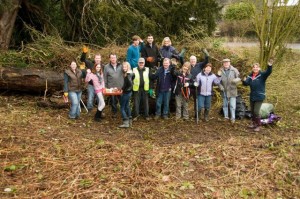 Extracts from Summer newsletter article by Mike van der Vord :
Extracts from Summer newsletter article by Mike van der Vord :
Our planting of several different UK indigenous aquatic plants last spring, has proven to have been very successful. The marginal plants only need to be cut back when the winter comes at the end of the year. The deeper water plants, water lilies included, are also thriving well.
Unfortunately someone deliberately introduced two clumps of ‘Lagarosiphon Major’ (CurlyWater Thyme) on both sides of the pond. This aggressive invasive plant has grown at an alarming rate and we will be reducing the weed physically at our next work party.
The perimeter banks of the pond are continuing to establish a good variety of wild flowers. Last year we planted a comprehensive selection of wild flower seeds which were all UK indigenous varieties. They have self seeded well this year. They include Red Campion,
Stinging Nettle, Dead Nettle, Garlic Mustard (the preferred food for the Orange Tip Butterfly), Dandelion, Poppy, Yellow Iris, Foxgloves, Red Clover, Common Vetch, Oxeye Daisy, Meadow Buttercup and Cow Parsley.
Coal Tits have been seen nesting in the magnificent yew tree by the pond. Bill
Bessant, one of our volunteers, has been diligently monitoring the ecology of the pond. He is keeping records of the plants, wild flowers, wild life, insect and invertebrate life in and around the pond. In his opinion the pond is doing very well, and despite the Curly Water Thyme, the water quality is good. Some of the insects spotted in May include: Broad Bodied Chaser, Common Blue Damselfly, Large Red Damselfly, Red Eyed Damselfly, Diving Bell Spider, Azure Damselfly Larvae and Mayfly Larvae.
Work parties usually take place on the first Saturday of every month from 9.30am up until midday. If you would like to get involved with the pond and join our team of volunteers please contact me at conservation@kenleyra.org.uk or Phil Royse at treasurer@kenleyra.org.uk.
See Wattendon Pond Photo Gallery

